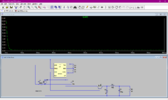Fluffyboii
Active Member
Hi, I have a project which is creating a step down converter that takes 12V and gives 5 volts. It is required to handle 10 Amps which is I think a bit overkill. Anyway since they don't teach us anything in Electronic classes other than stupid imaginary sinusoids most of my teammates doesn't know how to make a circuit. So I tried to create a simple oscillator with everyone's favourite 555 IC and gave the square wave output to the npn transistor. I need to implement some sort of feed-back to this circuit so voltage doesn't drop under heavier loads. I think I need a comparator to detect when voltage goes below 5V and increase the Duty cycle or frequency but since it is fixed by the resistors R1, R2 and the capacitor I don't know how I can change those. I don't want to use any special buck converter IC's for this circuit and keep it easy enough to explain to someone who doesn't know much about this sort of stuff. What can be done can someone explain.


